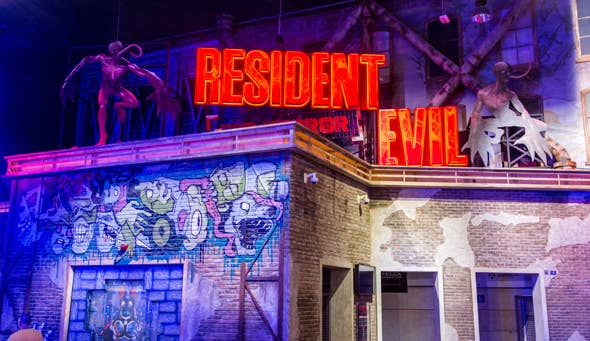Best practices for developing VR games for theme parks
Gamitronics founder Rajat Ojha explains the subtleties of developing VR content for location-based experiences
Imagine you're a virtual reality developer and you've made some games for consumer VR, but they failed to penetrate the cultural zeitgeist in any notable way.
In order to stay afloat, you'll need to search for contracts that require proficiency in VR development, ideally related to gaming. One potential avenue for this is developing licensed VR theme park attractions, as these are popping up all the time for major properties like Resident Evil, Battlefield and Final Fantasy (just to name a few we've worked on).
You may think that your experience in developing games for consumer VR would instantly make you an expert in designing a VR experience for a theme park attraction, but the truth is that it's vastly more complicated than that.
VR is an incredible tool, and theme parks are often looking to use well known gaming IPs to draw in the crowds
That's not to say that I don't think it's worth doing. Virtual reality is an incredible tool, and theme parks are often looking to use well known gaming IPs to draw in the crowds. In fact, it's a $72 billion industry! As such, amusement p ark imagineers need experienced VR developers to design these experiences.
To help guide VR game devs into this cottage industry, I'd like to share some of the lessons we learned at Gamitronics while transitioning from commercial VR game development to designing VR content for theme parks.
Time is of the essence
Commercial VR games can last several hours, allowing players to take their time learning complicated controls and exploring a large space. Theme park attractions don't have that luxury. A theme park attraction only lasts a few minutes.
What's more, you need to build up a story through decorations in the queue so visitors retain their excitement for the ride. You also need to ensure that there's a simple, intuitive way for people to remove their VR gear and exit in a timely manner so the next group of visitors can hop aboard.
Commercial VR games can last several hours. Theme park attractions don't have that luxury
With such a limited timeframe, you need to ensure that each attendee can grasp what to do and stay excited for the duration of the ride. For example, with our Resident Evil ride, we split it into six sections lasting 45 seconds each. Each section, triggered by the cart entering a new room, tasked players with shooting at virtual zombies as they shuffled towards them in real-time, with each player getting their own score, encouraging competition.
A hyper kinetic shooting gallery like this could quickly get exhausting in a commercial game, but after standing in line for a long time to build up to the experience, the snappy arcade action becomes an adrenaline rush that's thrilling to both fans of the franchise and newcomers alike.

Know your audience
When it comes to commercial games you can be pretty sure that the person playing your title is someone interested in games. I mean, they're playing it, after all. But with theme park attractions this isn't the case. Many attendees visit an amusement park for other reasons and want to try out an attraction even if they have no prior knowledge of its source material.
To get around this, we ensure that each licensed attraction we make has a prologue that introduces the audience to the world and scenario they're about to experience. That helps set the scene. Once the ride kicks off, there are no menus like you'd find in a commercial game, and we ensure that controls are straight forward with enough visual and audio cues to make everything legible to someone who's never played a game in this series before.
As for folks who are fans of the IP already, we make sure to throw in plenty of references to the source material that they can geek out over. Simply spotting the Umbrella Corp logo in a Resident Evil experience, or engaging with Cerberus in a Final Fantasy ride, is enough to make fanboys and girls squeal with glee! Sometimes something as little as an iconic sound effect can make a huge difference in capturing the spirit of the franchise you're building your experience around.

Quick onboarding is key
With commercial video games there are established rules to onboard new players. Typically this involves a tutorial of some kind, or at least a series of very simple challenges laid out to organically teach players how to play the game. Yet in a theme park scenario the entire experience only lasts three to five minutes, so you need to ensure that guests know exactly what to do, and how to do it, in a matter of seconds.
To achieve these, you must excise any menus or control options. This doesn't mean you need to dumb down the types of scenarios people get into. You can still have big, bombastic shootouts. But you'll need to ensure that the controls and hardware provided to the player are intuitive enough to understand straight away.
You need to ensure that guests know exactly what to do and how to do it in a matter of seconds
If a player is fumbling trying to figure out how to reload their gun, that's a problem. But if they understand what to do from the off, you can pack in a lot of quality content.
For example, our Battlefield experience contained five different levels, offering the kind of variety you'd expect in a full commercial game, only chiseled down into its core elements. As long as your onboarding is efficient, you can make a five minute ride feel like an entire adventure!

When it comes to hardware, expect the unexpected
When you develop a commercial VR title you know what hardware you'll be using and can base your game around that. Maybe you're creating an experience like Beat Saber where you have a headset and motion controls, or maybe you're making something that's developed to be paired with a DualShock 4 or a racing wheel controller. Either way, you know what you're getting into.
With amusement park rides, however, the hardware is a lot more novel. First of all, the controllers can be the size of an entire room, if the pod you're sitting in can be manipulated by the rider. There can also be sensors and cameras peppered throughout the ride reacting to your vessel. I'd say roughly 70% of the hardware we've had to work with was entirely new to us, as theme parks will often purchase the gear ahead of hiring a team to make something with it.

Digging through all of this can be daunting, but also liberating, as you get to be very creative with what you can make. One benefit of developing theme park attractions is that you're not bound to consumer PCs, and most theme parks are willing to throw some of the costliest hardware around to power your project. After all, not everyone can afford a high end PC, but theme park attractions are always expensive undertakings and the folks who fund these know it.
A word of warning though: developing for a theme park does require being hands-on with the attraction, as unlike a commercial game, rides can't be tested remotely. This may not be for everyone, but many VR developers would relish the chance to tinker with something physical like this, making each amusement park project feel like opening a new toy box!
Local multiplayer is highly recommended
Local multiplayer was one of the cornerstones of gaming during the 20th century, though it's largely fallen out of flavor over the last decade or two as online gaming has become the norm. While there are still some games that support split screen or other local multiplayer modes, these are few and far between.
But with a theme park attraction people have to be physically close to each other, so it's highly recommended that you use this opportunity to tie their experience together in either a competitive or cooperative way.
You could have attendees riding the same cart compete with each other as they shoot zombies. Or you could encourage players to work together to set a high score on a leaderboard/Hall of Fame. However you design it, we highly encourage making a theme park attraction as much of a shared experience as possible. This way attendees come out pumping their fists or jokingly taunting their friends and family. You might even get return attendees who want to go right back for a rematch!
Developing a VR theme park attraction requires a lot of outside the box thinking to solve issues that wouldn't be a problem in commercial games. This certainly makes it a challenge, but it's a fun challenge that keeps things fresh. As long as you keep in mind your audience, the scope and timing of your attraction, and the eclectic hardware you'll get to mess around with, you can create something wild and inventive that will appeal to both fans of established franchises, as well as oblivious passers by who want to see what technological hijinks are in store for them on their holiday.
Developing VR theme park attractions isn't easy, but it's always a novel, engaging project, that can be as creatively fulfilling as any commercial game.
Rajat Ojha is celebrating his 25th year in the interactive entertainment industry and is the CEO of Gamitronics. He's successfully built his companies in the USA and in India and has successfully transitioned his business from games to theme parks and arcades, and contributed to several theme parks across the globe.







